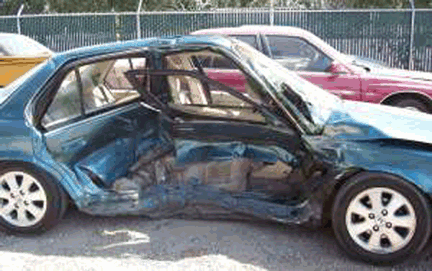Euro NCAP simulates this type of crash by having a mobile deformable barrier (MDB) impact the driver’s door at 30 mph. In the Institute's test, a 3,300-pound SUV-like barrier hits the driver side of the vehicle at 3o mph. Two SID-II dummies representing small (5th percentile) women or 12-year-old children are positioned in the driver seat and the rear seat behind the driver.
- When a vehicle is hit on the side by another vehicle, the crumple zones of the striking vehicle will absorb some of the kinetic energy of the collision.
- The crumple zones of the struck vehicle may also absorb some of the collision's energy, particularly if the vehicle is not struck on its passenger compartment. Both vehicles are frequently turned from their original directions of travel.
- If the collision is severe, the struck vehicle may be spun or rolled over, potentially causing it to strike other vehicles, objects, or pedestrians.
- After the collision, the involved vehicles may be stuck together by the folding of their parts around each other. An occupant on the struck side of a vehicle may sustain far more severe injuries than an otherwise similar front or rear collision crash.
This video show how the crash test doing and what happened during the test
Engineers look at three factors to determine side ratings: driver and passenger injury measures, head protection, and structural performance.
Injury measures: Injury measures from the two dummies are used to determine the likelihood that occupants would sustain significant injuries in a real-world crash. Measures are recorded from the head, neck, chest, abdomen, pelvis, and femur. These injury measures, especially the ones from the head and upper body, are major components of each vehicle's overall side rating.
Head protection: To supplement head injury measures, technicians put grease paint on the dummies' heads before each crash test. After the test, the paint shows what parts of the vehicle or the barrier came into contact with the heads. If the vehicle has airbags and they perform correctly, the paint should end up on them. In cases when the barrier hits a dummy's head during impact, the dummy usually records very high injury measures. That might not be true, however, with a "near miss" or a grazing contact. The paint, along with footage of the test recorded on high-speed film, helps identify such cases, which is important because small differences in occupants' heights or seating positions compared with those of the test dummies could result in a hard contact and high risk of serious head injury.
Structure/safety cage: Engineers assess the vehicle's structural performance by measuring the amount of intrusion into the occupant compartment around the B-pillar (between the doors). Some intrusion into the occupant compartment is inevitable in serious side impacts, but it shouldn't seriously compromise the driver and passenger space. As with head protection, this is another assessment that helps evaluate the injury risk of occupants who aren't exactly the same size or sitting in exactly the same positions as the dummies.
 In the real world, a driver of a vehicle rated good is 70 percent less likely to die in a left-side crash, compared with a driver of a vehicle rated poor. A driver of a vehicle rated acceptable is 64 percent less likely to die, and a driver of a vehicle rated marginal is 49 percent less likely to die.
In the real world, a driver of a vehicle rated good is 70 percent less likely to die in a left-side crash, compared with a driver of a vehicle rated poor. A driver of a vehicle rated acceptable is 64 percent less likely to die, and a driver of a vehicle rated marginal is 49 percent less likely to die. Although it is difficult to judge the level of protection provided from the extent of intrusion, control of how the car side intrudes is important. Through the programme, Euro NCAP has seen large improvements in side impact performance. The provision of side impact airbags has helped. It is now normal for the cars tested by Euro NCAP to be fitted with side impact airbags.


